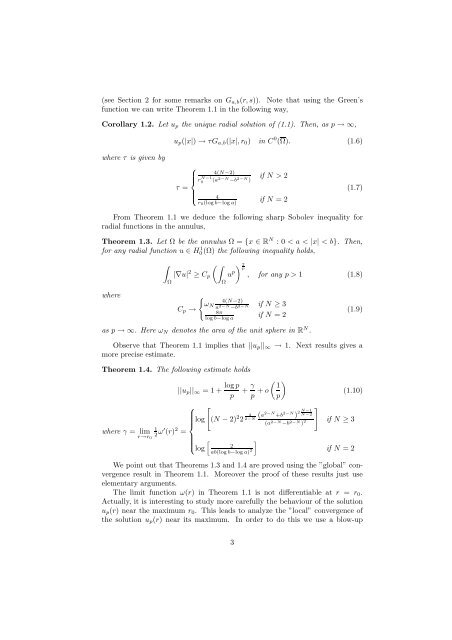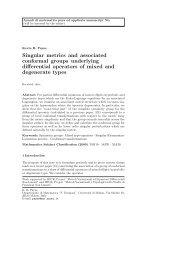Asymptotic behaviour of the Kazdan-Warner solution in the annulus ∗
Asymptotic behaviour of the Kazdan-Warner solution in the annulus ∗
Asymptotic behaviour of the Kazdan-Warner solution in the annulus ∗
You also want an ePaper? Increase the reach of your titles
YUMPU automatically turns print PDFs into web optimized ePapers that Google loves.
(see Section 2 for some remarks on Ga,b(r, s)). Note that us<strong>in</strong>g <strong>the</strong> Green’s<br />
function we can write Theorem 1.1 <strong>in</strong> <strong>the</strong> follow<strong>in</strong>g way,<br />
Corollary 1.2. Let up <strong>the</strong> unique radial <strong>solution</strong> <strong>of</strong> (1.1). Then, as p → ∞,<br />
where τ is given by<br />
up(|x|) → τGa,b(|x|, r0) <strong>in</strong> C 0 (Ω). (1.6)<br />
⎧<br />
⎪⎨<br />
τ =<br />
⎪⎩<br />
4(N−2)<br />
N −1<br />
r0 (a2−N −b2−N )<br />
4<br />
r0(log b−log a)<br />
if N > 2<br />
if N = 2<br />
(1.7)<br />
From Theorem 1.1 we deduce <strong>the</strong> follow<strong>in</strong>g sharp Sobolev <strong>in</strong>equality for<br />
radial functions <strong>in</strong> <strong>the</strong> <strong>annulus</strong>,<br />
Theorem 1.3. Let Ω be <strong>the</strong> <strong>annulus</strong> Ω = {x ∈ R N : 0 < a < |x| < b}. Then,<br />
for any radial function u ∈ H 1 0(Ω) <strong>the</strong> follow<strong>in</strong>g <strong>in</strong>equality holds,<br />
where<br />
<br />
|∇u|<br />
Ω<br />
2 ≥ Cp<br />
Cp →<br />
<br />
u<br />
Ω<br />
p<br />
2<br />
p<br />
<br />
ωN 4(N−2)<br />
a2−N −b2−N if N ≥ 3<br />
8π<br />
log b−log a if N = 2<br />
, for any p > 1 (1.8)<br />
as p → ∞. Here ωN denotes <strong>the</strong> area <strong>of</strong> <strong>the</strong> unit sphere <strong>in</strong> R N .<br />
(1.9)<br />
Observe that Theorem 1.1 implies that ||up||∞ → 1. Next results gives a<br />
more precise estimate.<br />
Theorem 1.4. The follow<strong>in</strong>g estimate holds<br />
1<br />
where γ = lim 2 r→r0<br />
ω′ (r) 2 =<br />
||up||∞ = 1 +<br />
log p<br />
p<br />
⎧ <br />
⎪⎨<br />
log (N − 2) 22 2<br />
⎪⎩<br />
<br />
log<br />
2<br />
ab(log b−log a) 2<br />
<br />
γ 1<br />
+ + o<br />
p p<br />
2−N (a2−N +b 2−N N −1<br />
2<br />
) N −2<br />
(a2−N −b2−N ) 2<br />
<br />
<br />
(1.10)<br />
if N ≥ 3<br />
if N = 2<br />
We po<strong>in</strong>t out that Theorems 1.3 and 1.4 are proved us<strong>in</strong>g <strong>the</strong> ”global” convergence<br />
result <strong>in</strong> Theorem 1.1. Moreover <strong>the</strong> pro<strong>of</strong> <strong>of</strong> <strong>the</strong>se results just use<br />
elementary arguments.<br />
The limit function ω(r) <strong>in</strong> Theorem 1.1 is not differentiable at r = r0.<br />
Actually, it is <strong>in</strong>terest<strong>in</strong>g to study more carefully <strong>the</strong> <strong>behaviour</strong> <strong>of</strong> <strong>the</strong> <strong>solution</strong><br />
up(r) near <strong>the</strong> maximum r0. This leads to analyze <strong>the</strong> ”local” convergence <strong>of</strong><br />
<strong>the</strong> <strong>solution</strong> up(r) near its maximum. In order to do this we use a blow-up<br />
3








